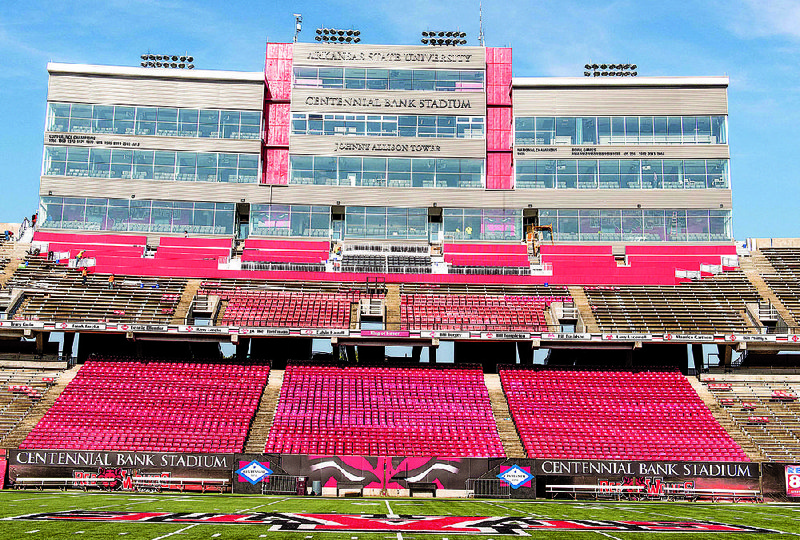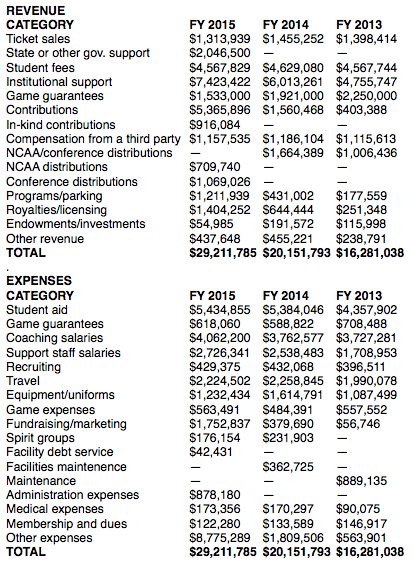Charles Welch remembers a phone call he took from an agitated donor to Arkansas State athletics in December 2011.
The donor, whom Welch didn't name, was concerned the school's football coach at the time, Hugh Freeze, was going to leave after winning a Sun Belt Conference championship in his first season.
"If y'all don't find a way to keep Coach Freeze, I'm going to pull my private funding," Welch, the Arkansas State University System president, recalls the donor telling him.
ASU couldn't keep Freeze. He left for Mississippi on Dec. 5 after leading the Red Wolves to their first outright Sun Belt title. But soon after, ASU introduced Gus Malzahn as its new coach, which prompted a phone call from the same donor offering Welch an apology.
"People saw we were able to take some chances, and we were willing to become invested in this," Welch said.
Almost six years later, not much has changed.
Welch was in his first year as system president at the time, and neither Chancellor Tim Hudson nor Athletic Director Terry Mohajir had been hired when the Freeze-to-Malzhan transition took place. But since Mohajir was hired in September 2012, a concerted effort to grow the capabilities of ASU athletics has progressed.
That task reached a new level in 2014-2015, when ASU spent a school-record $29,211,785 on athletics, according to NCAA financial reports. That number is up from $20,151,793 in 2013-2014 and is almost double the expenses in 2012-2013 of $16,281,038, the year Mohajir arrived.
Who gets the credit? Just about everybody, Mohajir said, pointing out Welch, Hudson, and alumni and fans who have helped ASU set records in ticket revenue and private donations. It's allowed ASU to go from $9.4 million in 2010, according to USA Today, to where it is now: third in the Sun Belt in spending and 32nd out of 61 Group of Five conference schools.
"From a perception standpoint, if you're going to play at this level, then you don't want to be [last]," Mohajir said. "You want to be relevant. You want to be in the conversation."
FUNDRAISING KICK
The first ASU football game held after Mohajir's hiring Sept. 19, 2012, was a 56-0 blowout of Alcorn State.
ASU lost the next week to Western Kentucky, but under Malzahn, it didn't lose another game while capturing another conference title. On-field production for ASU's most visible program had improved, but Mohajir thought the inner-workings to keep it going needed improvement, particularly fundraising.
In 2012-2013, $403,388 of ASU's athletic revenue came from outside contributions. That total increased to more than $1.5 million the next year. In 2014-2015, it was $5.36 million.
"We had a lot of dedicated people in our program," Mohajir said. "We just needed more."
Mohajir started by reorganizing its fundraising efforts. The Red Wolf Club became the Red Wolves Foundation -- "you join a club, you give to a foundation," he said -- then he added two staff members. Each hire has been made with a focus on fundraising.
"We had a concerted effort that we're hiring producers," he said. "Guys on our staff that are producing revenue and they're accountable for it."
Since Mohajir arrived, ASU has secured its largest donation from one person, the $5 million given in August 2014 by former letter winner and bank chairman Johnny Allison. That led to the construction of the Johnny Allison Tower, a collection of suites, loge boxes and other premium areas at Centennial Bank Stadium that was opened before last football season.
The Red Wolves Foundation claimed $6.07 million in revenue in 2015, up from $5.5 million the year before and $3.3 in 2013, according to tax documents. And while 2015-2016 revenue figures that would indicate how profitable the press box has been aren't available, Welch and Mohajir both said they were pleased with the turnout. Welch said every seat in the suites was sold for this football season.
Welch said last week that the completion of the press box, which came a few months after the completion of an indoor practice facility on the north end of the stadium, was as much of a symbolic completion as it was practical. It will generate revenue that will fund other projects and sports, but it also proved that a project so large could be completed in a year's time.
"Everyone that stepped inside that facility last year felt 'Wow, this is an entirely different game,' " Welch said. "It sent the message that we're not only in this thing, we're going to do it it the right way, and we're going to do it at the highest level and push the envelope forward."
The university is attempting to maintain that, particularly in football, which helps ASU tap into conference revenue brought in by the new College Football Playoff.
"We're not only building annual revenues now, we're building for the future," Mohajir said. "So, when we retire the debt service [on the press box] in 10 years, that's all going to be cash flow to the athletic department. We're looking at where we need to be in 10 years."
Football expenses at ASU were $15,072,254 in 2014-2015, almost $2.9 million more than its revenue and almost double what it was the year before. ASU spent $7,589,999 on football in 2014 and $6,319,206 in 2013. A large portion of that increase -- $6,741,089 -- was because of the construction of Allison Tower, and about $2 million more from ASU's education and general fund, which hadn't previously been tapped by athletics, was put into football.
Student fees roughly have stayed put -- $4.56 million in 2013, $4.62 in 2014 and $4.56 in 2015 -- but ASU's contribution to athletics has risen. It was more than $9.4 million in 2015, after it was $4.75 million in 2013.
Welch defends the funding, saying ASU athletic subsidies are less than most of its peers. The 48 percent of the athletic expenses that come from university sources is lower than all but Louisiana-Lafayette and Louisiana-Monroe among Sun Belt schools, according to USA Today's database.
"I think you have to look at athletics as an advertising and marketing expense," Welch said. "People are going to hear about our university and know more about our university because of athletics publicity more so than any other thing that we're going to do."
WHAT'S NEXT
Next up in terms of major capital projects is a football operations center that would fit between the indoor facility and the north end zone at Centennial Bank Stadium. First announced when Malzahn was coach in 2012, it will include new football locker rooms, coaches' offices and more premium seating.
The renovation will allow ASU to reorganize its athletic department offices, moving administrators to the south end zone complex and allow basketball offices to spread out inside the Convocation Center.
"We've got people on top of each other now," Mohajir said.
But smaller projects are on tap first, like a new track surface Mohajir said should be completed this summer. ASU is also looking at adding softball, which would be the first time it has added a sport since women's bowling in 2004.
"It's a funding issue," Mohajir said. "But we're absolutely looking at it."
Another benefit of a growing budget is positioning itself in case another round of conference realignment happens.
The Big 12 is exploring whether to add two schools and hold a conference championship football game. According to reports, Cincinnati, Memphis and Central Florida, all of the American Athletic Conference, are interested candidates. If that happens, and the shuffling affects the Sun Belt like it did four years ago, would ASU's $29 million budget put it in a better position?
"No question," Mohajir said. "We're in the conversation."
Welch said conference affiliation has been a topic of discussion.
"I wouldn't be telling you the truth if I didn't say that we have aspirations of improving our standing from a conference affiliation standpoint," Welch said. "I'm not sure we've sat back and said, 'This is the conference we want to get into, this is the year we want to do it,' because so much of that is fluid.
"Right now, our goal is to dominate our conference on an annual basis."
Sports on 05/08/2016

